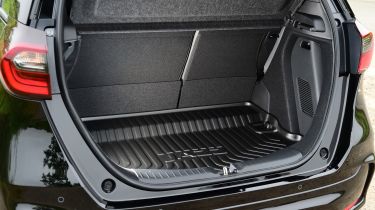Honda Jazz - Practicality, comfort and boot space
The Honda Jazz holds an ace card for practicality; nothing in the supermini class comes close to its versatility

Practicality and ease of use are where the Honda Jazz still really shines. Visibility for the driver is excellent, thanks to the slimmer A-pillars and high windscreen. This, along with an elevated driving position, a good view out of the rear window, standard parking sensors, and a reversing camera, means there shouldn’t be any problems with parking manoeuvres or navigating out of tight junctions. In fact, when we pitched the Jazz up against the Renault Clio and Skoda Fabia in a three-way supermini test, it easily stood out as the most versatile car.
One slightly irritating quirk that we found during our own test was that, due to the shallow cowl design, the digital instrument display was sometimes affected by sunlight. The main screen was easier to see, but the information on either side was harder to make out.
The famous Magic Seats in the second row are a brille of design. Not only do they split in 60/40 fashion, but you can also fold up the bases like a cinema seat to help you slide awkward larger items across the rear floor.
There are many useful cubby holes and storage bins for assorted items, while all versions include a front centre armrest, cupholders and seat back pockets for extra convenience.
Size
The Jazz is 4,089mm long, 1,694mm wide (excluding door mirrors, which take it to 1,966mm) and 1,526mm in height, which is a similar length to a Skoda Fabia. The SUV-inspired Jazz Crosstar is 16mm longer and is also slightly wider (at 1,725mmm) and taller (by 30mm) than the standard hatchback.
Leg room, head room & passenger space
The Jazz includes plenty of space for the driver, although Honda hasn’t forgotten about the needs of passengers – the cabin can easily accommodate four six-footers without any worries about knee or legroom. Despite a 10mm lower roofline, head room is still exceptional when compared to rivals.
Used - available now
We measured the rear seat area in the Honda Jazz when we pitted it against the Toyota Yaris Cross in our twin test. We found that the Jazz has the advantage when it comes to knee room, but the Yaris Cross offers slightly more headroom and its cabin is wider, too. Although the Toyota doesn’t provide any charging sockets in the rear, the Jazz has two handy USB-C ports for children in the back to charge their phones or tablets.
All versions of Jazz come with ISOFIX child seat mounting points on the outer positions of the rear bench.
|
Rear seat space comparison | |||
|
Knee room (min-max) |
Headroom |
Elbow room | |
|
Honda Jazz |
655-875mm |
910mm |
1,245mm |
|
Toyota Yaris Cross |
590-845mm |
930mm |
1,310mm |
Boot
The Jazz’s boot size is a decent 304 litres, which is more than the 289 litres a Clio offers, but can’t match the huge 380 litres of load space a Fabia provides. However, with the rear seats folded, the Honda supermini trumps both of these competitors with 1,205 litres of capacity. The Crosstar Advance has just as much luggage space as the standard car.
When we opened up the boot of the Jazz in our twin test against the Yaris Cross, we found that while the Honda has a lower lip, which helps when loading in heavier items, the Toyota has a much longer boot area with the rear seats in place. The load space in both cars is about the same width though.
|
Boot space comparison | |||
|
Length |
Width |
Lip height | |
|
Honda Jazz |
645mm |
1,015mm |
615mm |
|
Toyota Yaris Cross |
785mm |
1,000mm |
760mm |













